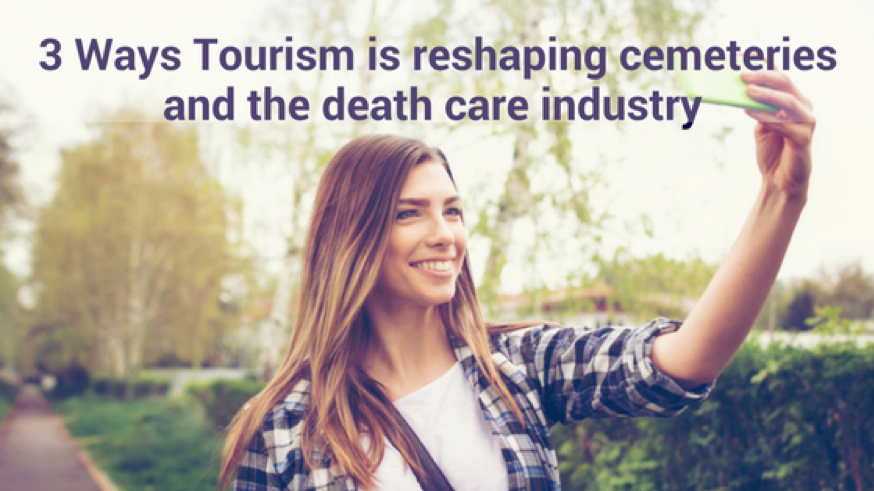The last decade has seen a boom in cemetery tourism, sometimes called Tombstone Tourism. With the rising interest in genealogy, more people are hunting out cemeteries to find their ancestors and trace their story. To feed this demand people who are interested, or even obsessed with cemeteries, or taphophiles are visiting and photographing cemeteries, headstones, and memorials and posting this information online.
For some people, their interest in cemeteries is more about the architecture, art, culture, and historical examples found within cemeteries. Each grave site and headstone is an example set in stone (or bronze) of the cultural norms of the day, religious preferences and personality and beliefs of the deceased. For older cemeteries particularly there is a wealth of history hidden within graveyards that are not always obvious to visitors. This unprecedented level of interest is reshaping the business of cemeteries in three significant ways:
ONE: Digital Tourism
The number of in-person tourists to a graveyard is minimal compared to the exposure of online interest – are you online yet?
Many cemeteries have or are in the process of digitally recording the details of all burials and memorials so that this information can be published, and Deceased Records can be searched. This information can be provided online through various registers and often links to the major genealogy sites, and through your own website if you have one. This information is for the most part freely available to anyone with access to the internet though with so many registers it can be confusing for the public so if they could go directly to the graveyard as the source they would, helping give your business new exposure.
How much time do you currently spend on Deceased Searches? For many cemeteries, these queries are their most common and take the most time to resource as records may still be on paper, damaged or even lost. Transcribing all your records to be online gives you the ability to quickly and accurately search records based on set criteria. This may not be tourism in the traditional sense, but anyone coming to your business for information is a potential customer.
Social channels like Facebook, Instagram, and Twitter allow your business to directly connect with the family of those buried in your grounds, your community, and those interested taphophiles we discussed earlier. You have direct access to your audience, and probably an audience you have not even identified in person, meaning you can promote activities and events, and your community can share these.
TWO: Cemetery / Tombstone Tourism
Many of the larger cemeteries now offer tours; some at night ghost tours and other curiosity or historical tours. Cemeteries provide an authentic insight into the beliefs and culture at the time of death. Indeed, in the cases of Catholic cemeteries and graveyards, there are centuries of history behind the symbolism that can be seen at these sites. Statues, shrines, and stained glass reiterate the promise of eternal life. Traditionally more affluent burials included beautifully artistic and ornate tombstones or crypts which must be seen to be believed.
Even small cemeteries and local government bodies are also experiencing a renewed interest in their cemeteries; allowing them to promote these sites as part of their local attractions and events. These events could include celebrations for mother’s and father’s day. For Catholic cemeteries, regular activities like mass to remember those who are buried within the grounds also provide an opportunity to invite a new audience into your cemetery.
Many retired and private cemeteries, with no new funds coming in from burials, benefit from this tourism as it brings in new revenue. For the “friends of” groups, Trusts and volunteers who otherwise manage these sites and interest and increase in income brings in much-needed funding while promoting your site.
THREE: Digital Mapping
GPS, or digital, mapping identifies the plots and memorials within your site. Your cemetery may currently have hand drawn plans, but how accurate are these, do they even resemble your grounds? Digital mapping pins each plot (or other) location to a set GPS coordinate to confirm the position within your grounds.
Meaning visitors to your cemetery can negotiate the grounds to find the location they are seeking. Imagine visiting a graveyard for the first time and being able to use Google Maps to direct you to a specific location or grave. This same technology allows visitors who are geographically remote to view these locations and even see photos of headstones and memorials if they are published online. Once again bringing a new audience to your business.
Mapping also allows cemeteries to identify Points of Interest, be they famous celebrities, unique architecture, historically significant sites, and much more. It is also a vital tool to manage inventory within the cemetery grounds by identifying those plots that are occupied, pre-sold, and those that are free – providing an instant view of availability.
Conclusion
Historically cemeteries were designed as parks to encourage visitors and mourners to explore – as attitudes towards death and the industry change, and the interest in genealogy continues to grow it makes perfect sense that cemeteries and memorial gardens are the next hot tourist destination. Educating your community about the unique history and even curiosities within your graveyard also helps promote your business and services.
Moreover, it is not just the larger cemeteries contributing to this growth; many websites are collecting and maintaining information on cemeteries gathered by volunteers. These sites allow visitors to cemeteries to post photos, transcribed headstone inscriptions and provide general cemetery information for the wider public to view. Meaning many of the smaller historical, private, or retired cemeteries are now visible to an international audience in a way that has never been possible before.
What are your thoughts on capitalizing on tourism and what insights do you have if you already offer these services?
Shared with CCFW for distribution by OpusXentra

